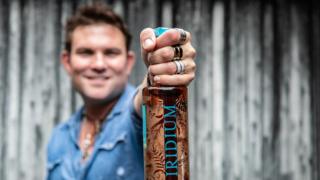Is rum about to become the new gin?
 Image copyright Alison George
Image copyright Alison George Rum distiller Mark Watkins is reflecting on his disastrous first attempt at making his own spirits when he was a teenager.
The then 16-year-old had set up a rudimentary distillery at the back of his parents’ banana farm in the small town of Walkamin, in north-eastern Queensland, Australia.
His questionable safety standards nearly saw the family’s crop go up in flames, and he almost poisoned his school friend.
«He’s still alive, but he doesn’t talk to me anymore,» says Mr Watkins, now 39.
Nevertheless, this stumble out of the starting blocks left him unperturbed. He was on a mission to make top-quality spirits, with the ultimate goal of creating the best rum in the world. Two decades later, he’s accomplished his mission.
Last year, the World Rum Awards named Mr Watkins’ Iridium rum «the world’s best pot still rum, five years old and under». It put his small business, Mt Uncle Distillery, on the global map.
Although the company is a tiny drop in the global spirits pool, Mt Uncle is one of a small but growing number of rum distilleries around the world taking the spirit in a new direction – low volume, premium production.
So, is rum now starting to follow the path set by gin over the past decade, which has seen a huge rise in the number of independent producers as demand has soared?
But first a reminder – what exactly is rum? It is a spirit made from distilling sugarcane juice, sugar cane syrup (concentrated juice), or sugarcane molasses, which is the thick, dark treacle you are left with after granulated sugar has been produced. It can be drunk neat, with water, a mixer or as a cocktail base.
A brief history of rum
- Rum is synonymous with the Caribbean, where the first modern rums were distilled on sugarcane plantations in the 17th Century
- The history of the spirit is intrinsically linked to slavery, as it was slaves working on the plantations who discovered that molasses, the dark treacle left over after sugar has been refined, could be fermented and then distilled into a spirit
- Rum also became associated with the British Royal Navy, with sailors being given a daily «rum ration» from 1850 until the practice was ended in 1970. A type of dark rum called «navy rum» is still made and sold by a number of producers
- Today the world’s largest exporter of rum in value terms is the US ($159m in 2018), followed by Germany ($150m), Italy ($142m), Cuba and the Dominican Republic (both $105m) and Guatemala ($98m)
Assessed in its entirety, global rum production – which is dominated by mass market brands produced in huge volumes – has flat-lined in recent years.
Total worldwide sales by volume of standard or value-priced rum grew just 0.6% from 2014 to 2019, according to the latest figures from research group IWSR Drinks Market Analysis.
Yet at the same time, «high-end rum» bottles costing $28 (£22.50) or above grew by 8.3% over the same period, says the organisation.
«I think, in general, new generations of [rum drinkers] are drinking less, but they’re drinking better,» says Roberto Serralles, a sixth-generation rum-maker. His family own and run Puerto Rican business Destileria Serralles, which has been making rum since 1865.
«The rum category is heavily weighted at the lower end, so the higher premium end is growing, but with small volume, and that’s why it gets lost.»
Many rum aficionados, like Mr Watkins, say that rum still has an inferior image, purveyed by cheap brands, and often, their subsequent hangovers.
«Lots of people got smashed on rum when they were 17, and haven’t given it another chance,» says the Australian. «Lots of people are familiar with cheaper brands, and [for small distilleries] it can be a hard game to crack into, as there are so many big multinational companies involved.»
Rum consultant, and World Rum Awards chair of judges, Peter Holland agrees that the rum industry has some repositioning to do. «A problem that we have in the rum world is that it’s represented invariably by price, and that price is low,» he says. «When you race to the bottom you’re not really driving up quality.»
Thus, Mr Holland’s passion lies in re-educating the market about rum. He feels it is a spirit that has enormous potential, and a level of complexity – attained through different distillation and aging techniques – that is currently not well marketed or understood.
As Queensland is a big grower of sugar cane, Mt Uncle has a ready source of sugar syrup from which to make its rum. In fact, Mr Watkins’ family farm in Walkamin, which is home to Mt Uncle Distillery, is right next to a sugar mill.
For rum producers in cooler countries where sugarcane cannot be grown, they typically rely on easily transportable and readily available molasses. This is the case at the UK’s Two Drifters Rum.
Located outside the city of Exeter in the south west of England, the company is run by husband and wife team Russ and Gemma Wakeham.
They started out making beer in 2019, with a small distillery on the side «for a bit of fun» but have now switched to solely making rum.
«It was completely driven by the fact that we couldn’t make enough of it,» says Russ.
The company buys its molasses from UK sugar producers including Tate & Lyle. It now produces a range of rums, with the spiced version being the bestseller – though Mr Wakeham admits that purists would not see spiced rum as a true representation of the spirit.
Mr Holland says that if rum wants to cement its move upmarket, the industry should stop categorising the drink by its colour.
«Colour is not a flavour,» he says. «I think white, gold and dark are very disingenuous terms to categorise a very diverse market.
«You don’t order gold whisky or dark cognac, so why should rum be tarred with that brush? If we can make the language around rum a bit more grown up, then I think we have a better chance of bringing people over [to the rum market].»
Mr Serralles says the industry also needs to better educate drinkers. «Most people don’t know what to do with rum.
«They’ve usually always thought of it as something you drink with Coke, or with an umbrella on vacation.»
With global rum sales totalling $16.5bn in 2019, according to the IWSR, it trails far behind vodka ($43.6bn) and whiskies ($74bn), but is still ahead of gin ($10.8bn).
So is rum really about to mirror gin’s huge growth in sales, and see a significant rise in the number of small producers as it surges in popularity?
«That’s the question on everyone’s lips,» says Mr Watkins. «I think rum could be the next boom spirit. It’s definitely due for it.»

